Compact USB Power Meters

- Power Meters with Sensors and USB 2.0 Connections
- Photodiode Sensors with Wavelength Ranges Between 350 to 1800 nm
- Thermal Sensors for 190 nm to 20 µm
- Power Meter Electronics Contained in Compact USB Housings
PM16-122
Power Meter with Photodiode Sensor, 700 - 1800 nm
PM16-130
Power Meter with Slim Photodiode Sensor, 400 - 1100 nm
PM16-401
Power Meter with Thermal Sensor, 190 nm - 20 µm
PM16-144
Power Meter with Integrating Sphere Sensor, 800 - 1700 nm

Please Wait
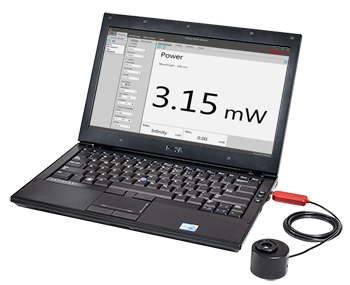
Click to Enlarge
The PM16-140C Integrating Sphere Power Meter connected to a laptop running the optical power monitor software.
| Power Meter Selection Guide |
|---|
| Sensors |
| Photodiode Power Sensors |
| Thermal Power Sensors |
| Thermal Position & Power Sensors |
| Pyroelectric Energy Sensors |
| Power Meter Consoles and Interfaces |
| Digital Handheld Console |
| Analog Handheld Console |
| Touchscreen Handheld Console |
| Dual-Channel Benchtop Console |
| USB Interfaces with External Readout |
| Complete Power Meters |
| Power Meter Bundles |
| Wireless Power Meters with Sensors |
| Compact USB Power Meters |
| Field Power Meters for Terminated Fibers |
Features
- USB 2.0 Power Meter Interface
- USB Stick Dimensions: 65 mm x 20 mm x 10 mm (2.60" x 0.80" x 0.40")
- Choose from Four Sensor Head Formats
- Standard Photodiodes: 400 to 1800 nm
- Slim Photodiode: 400 to 1100 nm
- Integrating Spheres: 350 to 1700 nm
- Thermal Sensor: 190 nm to 20 µm
- Compatible Fiber Connector Adapters Available Below
- All Sensor Heads Are Post Mountable
- Controlled via the Optical Power Monitor Software Package on Computers Running the Windows® Operating System (See the Software Tab for Details)
Thorlabs has integrated some of our most popular sensor head formats with a compact USB power meter interface that can be operated using a computer running the optical power monitor software (see the Software tab for download information). Sensor head options include our standard photodiode sensors, a slim-format photodiode sensor, integrating spheres, and a thermal sensor. A 1.5 meter cable* connects the sensor head to the power meter electronics, which are contained in a compact 65 mm x 20 mm x 10 mm (2.60" x 0.80" x 0.40") USB package. The power meter can be controlled by Thorlabs' Optical Power Monitor software installed on a computer running one of the Windows® 7 (SP1) through Windows 10 operating systems (see the Software tab for download information).
Standard Photodiode Sensors
Three of these power meters use Thorlabs' standard photodiode sensors and are available with either a silicon photodiode for 400 to 1100 nm or a germanium photodiode for 700 to 1800 nm. The PM16-120 and PM16-121 silicon photodiode sensors can detect optical powers between 50 nW to 50 mW and 500 nW to 500 mW, respectively, while the PM16-122 germanium photodiode sensor is designed to measure optical powers between 50 nW and 40 mW. Photodiode sensors are an excellent choice for applications that require a fast response time or high resolution but do not need a sensor with a flat spectral response.
Slim Photodiode Sensor
The PM16-130 power meter uses one of Thorlabs' slim photodiode sensor heads, ideal for applications with limited space and accessibility. The sensor head uses a large-area silicon photodiode sensitive to wavelengths between 400 to 1100 nm in a compact package that is just 5 mm thick on the sensor side. A built-in, slideable neutral density filter allows this power meter to take measurements of optical powers between 500 pW and 5 mW (without filter) or up to 500 mW (with filter).
Integrating Sphere Photodiode Sensors
Integrating sphere sensors can provide entrance-angle-independent power measurements of non-uniform or diverging beam shapes. They are available with either a silicon photodiode sensor for 350 to 1100 nm (Item # PM16-140) or a germanium photodiode sensor for 800 - 1700 nm (Item # PM16-144). Both sensors can detect optical powers between 1 µW and 500 mW.
Thermal Power Sensors
Three of Thorlabs' Thermal Power Sensors are available with the compact USB power meter interface. Thermal sensors are well suited for use in a wide range of applications, particularly those requiring a flat spectral response. They are additionally useful for applications with ultrashort pulses where high peak power would saturate a photodiode sensor. The S401C and S405C sensor heads provide low-power, ≤1 W and ≤5 W, respectively) and high-resolution (1 µW and 5 µW, respectively) measurements, and the S401C additionally uses active background compensation for low-drift measurements. The S425C has a fast response (<0.6 s) and accepts continuous optical inputs up to 10 W.
USB Power Meter Interface
These extremely compact power meters feature similar internal electronics to Thorlabs' PM160 and PM160T Wireless Power Meters and can be controlled via a computer running the optical power monitor software (see the Software tab).
All of the power meters available on this page have externally SM1-threaded input apertures or included adapters, except for the PM16-130 for which the SM1A29 adapter (available below) must be purchased separately. These threads allow the sensor heads to be used with our selection of internally SM1-threaded fiber adapter caps, available below.
Calibration
Each sensor head is individually calibrated and is shipped with a NIST- and PTB-traceable calibration certificate. The calibration and identification data is stored in the power meter's USB stick housing and applied to calculate accurate power measurements. For more information on sensor calibration, please see the Calibration tab on our Power Meter and Sensor Tutorial.
Recalibration Services
Thorlabs offers recalibration services for all of our power meters. To ensure accurate measurements, we recommend recalibrating these power meters annually. To order this service, scroll to the bottom of the page and select the appropriate Item # that corresponds to your power meter.
If you are interested purchasing a Thorlabs sensor head with a compact USB power meter interface that is not offered below, please contact Tech Support for information on custom options.
*If a longer cable length than 1.5 m is required, Thorlabs also offers USB extension cables in a variety of lengths.
USB Power Meters with Standard Photodiode Sensors
| Item # | PM16-120 | PM16-121 | PM16-122 |
|---|---|---|---|
| Detector Type | Large Area Silicon Photodiode |
Large Area Germanium Photodiode |
|
| Wavelength Range | 400 - 1100 nm | 700 - 1800 nm | |
| Optical Power Measurement Range |
50 nW - 50 mW | 500 nW - 500 mW | 50 nW - 40 mW |
| Optical Power Resolution |
<1 nW | <10 nW | <2 nW |
| Calibration Uncertaintya,b | ±3% (451 - 1000 nm) ±5% (Over Rest of Range) |
±5% | |
| Linearity | ±0.5% | ||
| Active Area Uniformityb | ±1% | ||
| Max Average Power Densityc | 20 W/cm² | 10 W/cm² | |
| Optical Filter / Diffuser | Reflective ND (OD1) | Reflective ND (OD2) | Absorptive ND (Schott NG9) |
| Response Time | <1 µs | ||
| Sensor Active Area | 9.7 mm x 9.7 mm | ||
| Sensor Aperture | Ø9.5 mm | ||
| Power Meter Electronics Properties | |||
| Analog Measurement Rangesd | 500 nA, 50 µA, 5 mA | ||
| Measurement Units | W, dBm, A | ||
| AD Converter | 24 Bit | ||
| Analog Amplifier Bandwidth | 10 Hz | ||
| Update Rate | 10 Hz | ||
| Remote Interface | USB 2.0 | ||
| Power Supply | External: 5 V DC via USB | ||
| Dimensions | |||
| Sensor Head Dimensions | Ø30.5 mm x 12.7 mm (1.20" x 0.50") |
||
| USB Housing Dimensions (Including Plug) |
65 mm x 20 mm x 10 mm (2.60" x 0.80" x 0.40") |
||
| Cable Length | 1.5 m | ||
| Weight | 0.07 kg | ||
| Mounting | |||
| Aperture Thread | External SM1 (1.035"-40) | ||
| Post Mounting | 8-32 and M4 Combined Tap | ||
| Compatible Fiber Adapter Item #'s |
S120-FC, S120-APC, S120-SMA, S120-ST, S120-SC, S120-LC, S120-25 (Not Included) |
||
USB Power Meter with Slim Photodiode Sensor
| Item # | PM16-130 |
|---|---|
| Detector Type | Large Area Silicon Photodiode |
| Wavelength Range | 400 - 1100 nm |
| Optical Power Measurement Range |
500 pW - 5 mW (Up to 500 mW with Filter) |
| Optical Power Resolution | <100 pW (10 nW with Filter) |
| Calibration Uncertaintya,b | ±3% (451 nm - 1000 nm) ±5% (Over Rest of Range) |
| Linearity | ±0.5% |
| Active Area Uniformityb | ±1% |
| Max Average Power Densityc | 20 W/cm² |
| Max Pulse Energy Density | 0.2 J/cm² (1 µs Pulse), 2 J/cm² (1 ms Pulse) |
| Optical Filter / Diffuser | Reflective ND (OD2) with Diffuser |
| Response Time | <1 µs |
| Sensor Active Area | 9.7 mm x 9.7 mm |
| Sensor Aperture | Ø9.5 mm |
| Power Meter Electronics Properties | |
| Analog Measurement Rangesd | 500 nA, 50 µA, 5 mA |
| Measurement Units | W, dBm, A |
| AD Converter | 24 Bit |
| Analog Amplifier Bandwidth | 10 Hz |
| Update Rate | 10 Hz |
| Remote Interface | USB 2.0 |
| Power Supply | External: 5 V DC via USB |
| Dimensions | |
| Sensor Head Dimensions | 150.0 mm x 19.0 mm x 10.0 mm (5.91" x 0.75" x 0.39") 5 mm Thickness on Sensor Side |
| USB Housing Dimensions (Including Plug) |
65 mm x 20 mm x 10 mm (2.60" x 0.80" x 0.40") |
| Cable Length | 1.5 m |
| Weight | 0.125 kg |
| Mounting | |
| Aperture Thread | External SM1 (1.035"-40) Threads with Optional Adapter Item #: SM1A29 (Not Included) |
| Post Mounting | 8-32 and M4 Taps |
| Compatible Fiber Adapter Item #'s |
S120-FC, S120-APC, S120-SMA, S120-ST, S120-SC, S120-LC, S120-25 (Not Included) When Used with Optional SM1A29 Adapter |
USB Power Meters with Integrating Sphere Sensor
| Item # | PM16-140 | PM16-144 |
|---|---|---|
| Detector Type | Integrating Sphere (Silicon Photodiode) |
Integrating Sphere (InGaAs Photodiode) |
| Wavelength Range | 350 - 1100 nm | 800 - 1700 nm |
| Optical Power Measurement Range | 1 µW - 500 mW | |
| Optical Power Resolution | <1 nW | |
| Calibration Uncertaintya | ±3% (451 nm - 1000 nm) ±5% (Over Rest of Range) |
±5% |
| Linearity | ±0.5% | |
| Max Average Power Densityb | 1 kW/cm² | |
| Integrating Sphere Material / Diameter | Zenith® PTFE Integrating Sphere / Ø1" | |
| Response Time | <1 µs | |
| Sensor Active Area | 3.6 mm x 3.6 mm | Ø2 mm |
| Sensor Aperture | Ø5 mm | Ø5 mm |
| Power Meter Electronics Properties | ||
| Analog Measurement Rangesc | 500 nA, 50 µA, 5 mA | |
| Measurement Units | W, dBm, A | |
| AD Converter | 24 Bit | |
| Analog Amplifier Bandwidth | 10 Hz | |
| Update Rate | 10 Hz | |
| Remote Interface | USB 2.0 | |
| Power Supply | External: 5 V DC via USB | |
| Dimensions | ||
| Overall Sensor Dimensions | Ø45 mm x 30.5 mm (1.77" x 1.20") |
|
| USB Housing Dimensions (Including Plug) |
65 mm x 20 mm x 10 mm (2.60" x 0.80" x 0.40") |
|
| Cable Length | 1.5 m | |
| Weight | 0.2 kg | 0.2 kg |
| Mounting | ||
| Aperture Thread | Removable Adapter Plate with External SM1 (1.035"-40) Thread |
|
| Post Mounting | 8-32 and M4 Taps | |
| Compatible Fiber Adapter Item #'s | S120-FC (Included) S120-APC, S120-SMA, S120-ST, S120-SC, S120-LC, S120-25 (Not Included) |
|
USB Power Meter with Thermal Sensors
| Item # | PM16-401 | PM16-405 | PM16-425 |
|---|---|---|---|
| Detector Type | Thermal Surface Absorber (Thermopile) with Background Compensation |
Thermal Surface Absorber (Thermopile) |
|
| Wavelength Range | 190 nm - 20 µm | ||
| Optical Power Measurement Range | 10 µW - 1 W | 100 µW - 5 W | 2 mW - 10 W |
| Max Average Optical Power Densitya | 500 W/cm² | 1.5 kW/cm² | |
| Max Pulse Energy Density | 0.2 J/cm² (1 µs Pulse), 2 J/cm² (1 ms Pulse) |
0.3 J/cm² (1 ns Pulse), 5 J/cm² (1 ms Pulse) |
0.3 J/cm² (1 ns Pulse), 5 J/cm² (1 ms Pulse) |
| Max Intermittent Powerb | 3 W | - | 20 W |
| Linearity | ±0.5% | ||
| Optical Power Resolutionc | 1 µW | 5 µW | 100 µW |
| Measurement Uncertaintyd (Calibration Uncertainty) |
±3% @ 1064 nm ±5% @ 190 nm - 10.6 µm |
±3% @ 1064 nm ±5% @ 250 nm - 17 µm |
|
| Response Timee | 1.1 s | 1.1 s | 0.6 s |
| Optical Coating | Black Broadband Coating | High Power Broadband Coating | |
| Sensor Aperture | Ø10 mm | Ø10 mm | Ø25.4 mm |
| Sensor Active Area | 10 mm x 10 mm | 10 mm x 10 mm | Ø27 mm |
| Distance to Detectorf | 3 mm | 5 mm | 4.6 mm |
| Active Area Uniformity | ±1% (Beam Diameter >1 mm) | ||
| Cooling | Convection (Passive) | ||
| Temperature Sensor (In Sensor Head) |
NTC Thermistor | ||
| Power Meter Electronics Properties | |||
| Analog Measurement Rangesc | 1.6 mV, 25 mV, 400 mV | 1.6 mV, 25 mV, 400 mV | 2.56 mV, 16 mV, 100 mV |
| Measurement Units | W, dBm, V | ||
| AD Converter | 24 Bit | ||
| Analog Amplifier Bandwidth | 10 Hz | ||
| Update Rate | 10 Hz | ||
| Remote Interface | USB 2.0, Type-A Connector | ||
| Power Supply | External: 5 V DC via USB | ||
| Dimensions | |||
| Dimensions of the Sensor Head | 43.0 mm x 33.0 mm x 15 mm (1.69" x 1.30" x 0.59") |
40.6 mm x 40.6 mm x 16.0 mm (1.60" x 1.60" x 0.63") |
50.8 mm x 50.8 mm x 35.0 mm (2.00" x 2.00" x 1.38") |
| USB Housing Dimensions (Including Plug) |
65.0 mm x 20.0 mm x 10.0 mm (2.56" x 0.79" x 0.39") |
||
| Cable Length | 1.5 m | ||
| Weight | 0.07 kg | 0.10 kg | 0.22 kg |
| Mounting | |||
| Aperture Threadg | for Mounting Ø1" Lens Tubes and Fiber Adapters |
for Mounting Ø1" Lens Tubes and Fiber Adapters |
External SM1-Threaded Adapter for Mounting Ø1" Lens Tubes and Fiber Adapters |
| Post Mounting | Ø1/2" Post via Universal 8-32 & M4 Tap (Post Not Included) | ||
| Cage Compatibility | N/A | 30 mm Cage Systems via Two 4-40 Tapped Holes; Two Ø6 mm Through Holes for ER Series Rods |
N/A |
| Compatible Fiber Adapter Item #'s | S120-FC, S120-APC, S120-SMA, S120-ST,S120-SC, S120-LC, S120-25 (Not Included) | ||
Compatible Power Meters
- Consoles:
- PM100A Analog Power and Energy Meter Console
- PM100D Digital Power and Energy Meter Console
- PM400 Capacitive Touchscreen Power and Energy Meter Console
- PM5020 Dual-Channel Benchtop Optical Power and Energy Meter Console (Version 4.0 or Later)
- Complete Power Meters:
- PM160, PM160T, and PM160T-HP Wireless Handheld Power Meters with Bluetooth® Technology
- PM16 Series Compact USB Power Meters
- PM60 and PM61 Fiber Optic Power Meter Series (Version 6.0 or Later)
- Interfaces:
- PM101 Series Power Meter Interfaces with External Readout (Version 2.0 or Later)
- PM102 Series Power Meter Interfaces with External Readout (Version 2.1 or Later)
- PM103 Series Power Meter Interfaces with External Readout (Version 3.0 or Later)
- PM100USB USB Interface Digital Power and Energy Meter
Optical Power Monitor
The Optical Power Monitor GUI software features power measurement, readout from up to eight power meters, and remote wireless operation.
For details on specific software features, please see the user manual.
Users interested in the legacy Power Meter Software can find it by visiting the software page.
The PM101 Series Power Meters are only compatible with version 2.0 or later. The PM102 Series Power Meters are only compatible with version 2.1 or later. The PM103 Series Power and Energy Meters are only compatible with version 3.0 or later. The PM5020 Console is only compatible with version 4.0 or later. The PM60 and PM61 Power Meter Series are only compatible with version 6.0 or later.
Optical Power Monitor GUI Software for Touchscreen, Handheld, and USB-Interface Power Meters
Features
- Operate up to Eight Power Meters Simultaneously
- Record and Analyze Measurements in Real Time
- Intuitive Analog Display and Graphing Modes
- Configurable Long-Term Data Logging
- Also Supports Position Measurements with Thermal Position & Power Sensors
- Compatible with USB and Bluetooth® Connections
The Optical Power Monitor software GUI enables seamless control of up to eight power meters that are connected via USB, RS232, or Bluetooth® wireless technologya. The latest software, firmware, drivers, and utilities for these power meters can be downloaded here.
Multiple data measurement and analysis functions are integrated into the GUI package. The interface offers a user-friendly design with minimal use of color and low brightness that is ideal use in dark lab environments while wearing laser safety glasses. Measured data can be displayed in real time as a simulated analog needle, digital values, line graph, or bar graph. Continuously logged and short-term measurements can be recorded for data viewing and analysis at a later point. A built-in statistics mode analyzes measured data and continuously updates to reflect new measurements within the pre-determined measurement period. Beam position measurements are also supported when used with our thermal position & power sensors.
The Optical Power Monitor software package installs the GUI, which then can be used to control the touchscreen, handheld, or USB-interface power meters. Firmware updates for supported power meters are also available. Programming examples and drivers for interfacing with our power and energy meter consoles using LabVIEW, C/C++, Visual C#, and Python are installed with the software; refer to the manual for details.
Please note that the Optical Power Monitor Software uses different drivers than the Power Meter Utilities Software and Thorlabs recommends using the new driver TLPM.dll. For users who wish to use the legacy Power Meter Software or use custom software designed using the older PM100D.dll driver, a Power Meter Driver Switcher program is included for easy swapping of the installed driver between the two versions.
a. The PM61 Series, PM160, PM160T, and PM160T-HP power meters are equipped with Bluetooth® connections.
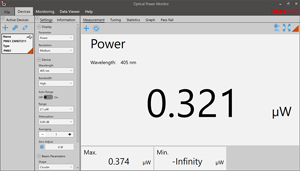
Click to Enlarge
Power Measurement Mode: Set up and configure up to eight power meters.
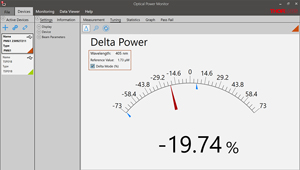
Click to Enlarge
Power Tuning Mode: Simulated analog needle and digital measurement value provided. Delta Mode, enabled above, shows the fluctuation range during the measurement period.
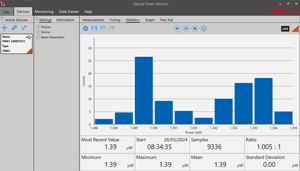
Click to Enlarge
Power Statistics Mode: Calculate numerical statistics for a pre-determined measurement period. The panel displays the analyzed values in a bar graph and the results as numerical values.
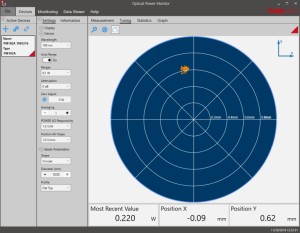
Click to Enlarge
Position Tuning Mode: Tuning mode can be used with a thermal position & power sensor to aid in beam alignment.
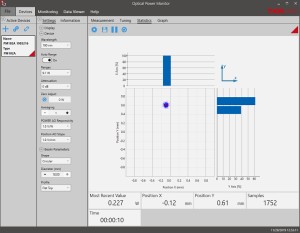
Click to Enlarge
Position Statistics Mode: Statistics mode also provides aggregate information for thermal position & power sensors.
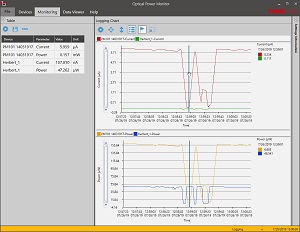
Click to Enlarge
Data Logging: Enable long-term measurement and simultaneous recording from up to eight power meters. Save data as .csv files for later processing while measurement results are displayed in a graph in real time.
Pulsed Laser Emission: Power and Energy Calculations
Determining whether emission from a pulsed laser is compatible with a device or application can require referencing parameters that are not supplied by the laser's manufacturer. When this is the case, the necessary parameters can typically be calculated from the available information. Calculating peak pulse power, average power, pulse energy, and related parameters can be necessary to achieve desired outcomes including:
- Protecting biological samples from harm.
- Measuring the pulsed laser emission without damaging photodetectors and other sensors.
- Exciting fluorescence and non-linear effects in materials.
Pulsed laser radiation parameters are illustrated in Figure 1 and described in the table. For quick reference, a list of equations is provided below. The document available for download provides this information, as well as an introduction to pulsed laser emission, an overview of relationships among the different parameters, and guidance for applying the calculations.
|
Equations: |
||||
 |
and |  |
||
 |
||||
 |
||||
 |
||||
Peak power and average power calculated from each other: |
||||
 |
and |  |
||
| Peak power calculated from average power and duty cycle*: | ||||
 |
*Duty cycle ( ) is the fraction of time during which there is laser pulse emission. ) is the fraction of time during which there is laser pulse emission. |
|||

Click to Enlarge
Figure 1: Parameters used to describe pulsed laser emission are indicated in the plot (above) and described in the table (below). Pulse energy (E) is the shaded area under the pulse curve. Pulse energy is, equivalently, the area of the diagonally hashed region.
| Parameter | Symbol | Units | Description | ||
|---|---|---|---|---|---|
| Pulse Energy | E | Joules [J] | A measure of one pulse's total emission, which is the only light emitted by the laser over the entire period. The pulse energy equals the shaded area, which is equivalent to the area covered by diagonal hash marks. | ||
| Period | Δt | Seconds [s] | The amount of time between the start of one pulse and the start of the next. | ||
| Average Power | Pavg | Watts [W] | The height on the optical power axis, if the energy emitted by the pulse were uniformly spread over the entire period. | ||
| Instantaneous Power | P | Watts [W] | The optical power at a single, specific point in time. | ||
| Peak Power | Ppeak | Watts [W] | The maximum instantaneous optical power output by the laser. | ||
| Pulse Width |  |
Seconds [s] | A measure of the time between the beginning and end of the pulse, typically based on the full width half maximum (FWHM) of the pulse shape. Also called pulse duration. | ||
| Repetition Rate | frep | Hertz [Hz] | The frequency with which pulses are emitted. Equal to the reciprocal of the period. | ||
Example Calculation:
Is it safe to use a detector with a specified maximum peak optical input power of 75 mW to measure the following pulsed laser emission?
- Average Power: 1 mW
- Repetition Rate: 85 MHz
- Pulse Width: 10 fs
The energy per pulse:

seems low, but the peak pulse power is:

It is not safe to use the detector to measure this pulsed laser emission, since the peak power of the pulses is >5 orders of magnitude higher than the detector's maximum peak optical input power.
| Posted Comments: | |
user
(posted 2024-08-23 09:14:14.18) Hi, i am using a PM16-121 and wonder if there is any polarization dependence in the range 400-1100 nm? Is the calibration performed with unpolarized light? Thanks jjadvani
(posted 2024-08-23 09:56:57.0) Dear Felani, Thank you for contacting Thorlabs. For this wavelength range, we employ a non-polarized quartztungsten halogen lamp as the light source. Following that, we employ a triple grating monochromator to select the exact wavelength for calibration, which helps to polarize light slightly but not much. You may learn more about how these sensors are calibrated by clicking on the link below. https://www.thorlabs.com/NewGroupPage9_PF.cfm?ObjectGroup_ID=6188 . I will contact you directly to discuss your issue further. Jie Zhu
(posted 2024-05-06 11:24:15.607) I bought PM16-120 and SM1FCA but seems still missing an adapter ring,please advise which part I should order hchow
(posted 2024-05-06 10:11:13.0) Dear Mr. Zhu, thank you for your valuable feedback. It appears to me that you might have purchased the wrong terminated fiber adapter for your PM16-120. The S120-APC is the correct fiber connector to get. I will personally reach out to you to see how best we can help you. Thank you. Tomas Popelar
(posted 2024-02-14 12:33:34.18) Using the PM16-130 can it be used to detect energy of every laser pulse (repetition rate 500 Hz)?Or is some averaging involved in the measurement? hchow
(posted 2024-02-15 11:30:21.0) Dear Mr. Popelar, thank you for your feedback. The PM16-130's refresh rate is 10 Hz. The average power of 50 or so pulses will be generate the final power measurement reading on your PC. In any case, I will personally reach out to you to provide more information. Patrick Tapping
(posted 2023-06-04 22:00:55.0) Regarding my question below about using these power meters on Linux, they do work fine. I had just forgotten to add the new udev rule to allow read/write access to the device.
After adding the new USB vid=0x1313 and pid=00x807c the PM16-425 works just the same as the PM100 and PM400 using the python pyvisa and ThorlabsPM100 libraries obtained from pypi. GBoedecker
(posted 2023-06-05 07:19:04.0) Dear Patrick, thank you very much for letting us know that it is working now and providing the solution for other users. Patrick Tapping
(posted 2023-06-02 00:44:04.307) Hi,
I have been using both a PM100 and PM400 via USB for remote/headless data logging on a Linux machine using the VISA interface. I just got a PM16-425 as I thought it would be perfect for my application since the display and bulk of the meter body is unnecessary. The "Spec Sheet" on the downloads page (https://www.thorlabs.com/_sd.cfm?fileName=MTN010479-S01.pdf&partNumber=PM16-425) says that it should also use the VISA protocol but on further reading that doesn't appear to be the case?
Is there an older firmware that I can install to get VISA capability or some other way of talking to this device in Linux?
Regards,
Patrick GBoedecker
(posted 2023-06-05 07:25:56.0) Thank you for your feedback. The PM-425 works with the VISA protocol like your other powermeters. See next post. Arun Jana
(posted 2023-01-09 13:16:47.357) for this instrument how we will get the software? and what is the compatibility? hkarpenko
(posted 2023-01-10 07:16:46.0) Dear Arun,
thank you for your feedback.
The software for controlling the power meter via PC can be downloaded directly from our website, a download link can be found in the software tab of this website.
I contact you directly to discuss the compatibility further with you. Ivan Kuyanov
(posted 2022-10-26 10:42:00.837) Hello, Could you send the appropriate drivers and instructions to operate your USB power meters it at linux? We have PM16-130 and we would like to use it under Linux. dpossin
(posted 2022-10-31 05:16:12.0) Dear Ivan,
Thank you for your feedback. I reach out to you in order to provide further information. jason kim
(posted 2022-08-10 10:47:54.03) Thank you for feedback! So, if I enter the beam diameter in the optical powermeter software in mm, the software calculates automatically and know can I think the measured data X "mW" (power) means X "mW/mm^2"(power density) ? jason kim
(posted 2022-08-09 11:44:14.387) Hi, how can I calculate the optical power density from PM16-121 ?
if the data is measured X mW, can I just calculate the density by dividing the data with the area of the aperture(Φ9.5)? dpossin
(posted 2022-08-09 08:32:59.0) Dear Jason,
Thank you for your feedback! The power density is the optical power divided by the beam area which is the beam radius^2 times pi (the circle constant). Either you do the math yourself or you just enter the beam diameter in the optical powermeter software. I reach out to you in order to provide further help. Jacob Thomas
(posted 2022-05-12 08:35:01.923) Hello,
Rather than feedback, a set of questions. I need to measure the power of broadband sources. I normally use your thermal power sensors to do so, but I need faster response time and less interference from relative humidity that I have experienced with the thermal power meters. I was wondering could the PM120 be used with a response flattening filter like your free space biased photodiode detectors? if so would it require a recalibration with this filter attached? Would the software need to recognise this sensor as something else other than a standard pm120 to get the correct readings accounting for the effect of the response flattening filter or would that be dealt with by correcting the the calibration files stored on board the sensor itself?
thanks
jacob soswald
(posted 2022-05-13 10:07:29.0) Dear Jacob,
thank you for your feedback. For measuring broadband light sources with photodiode sensors we would recommend the spectral correction function of the PM400. I have reached out to you directly to discuss this in more detail. lau yan
(posted 2022-04-06 10:46:14.063) the PM16-130 can't connect with the computer Kuang-Po Chang
(posted 2022-02-10 17:32:12.707) Possible to acquire data via Matlab? soswald
(posted 2022-02-11 10:03:26.0) Dear Kuang-Po Chang,
thank you for your feedback. It is possible to integrate our power meters into your Matlab routine, I have reached out to you directly to provide further assistance. James Ludlam
(posted 2022-02-02 09:47:49.33) Is there an API to allow users to integrate taking measurements into their own software? wskopalik
(posted 2022-02-04 05:07:06.0) Thank you very much for your feedback!
Yes, there is an API. The necessary driver files, VIs, etc. are installed with the Optical Power Monitor software package available in the software tab. The folders in which you can find these files are listed in the manual of the Optical Power Monitor software.
I will contact you directly to provide further information. ik Ha
(posted 2021-11-18 03:58:12.537) Hello
I bought the power meter(PM16-425) and PM102 power meter interface(PM102). The power meter is a USB type and the power meter interface is a serial type. Is it possible to use a USB-serial port gender to connect two products?
Reply please. wskopalik
(posted 2021-11-18 11:35:42.0) Thank you very much for your feedback!
The PM16-425 can be directly connected to a computer without the need for an additional interface. It has all the measurement electronics already integrated in the USB stick. The PM102 is not necessary in this case. The two devices cannot be connected in any way either.
I will contact you directly to provide further assistance. John Chiue
(posted 2021-08-24 16:56:42.163) Hi All,
Because the Max Pulse Energy of this power meter is 0.3 J/cm² (1 ns Pulse) on the specifications sheet.
I'd like to confirm if this power meter damaged when my laser is 3-6 ns pulse width, 10 Hz and energy 380 mJ/cm^2 at ~8 mm (1/e² diameter) which is around 1.5 J/cm².
Thanks! soswald
(posted 2021-08-26 08:13:03.0) Dear John,
thank you for your feedback. The 1.5 J/cm² of your laser indeed exceed the damage threshold of 0.3 J/cm² for ns pulses of the PM16-425.
For lasers with high peak powers we recommend sensors like S370C or S470C. Carsten Stock
(posted 2021-07-06 02:26:33.733) Hello, I encouter some issues with the PM16-120 and PM16-121 detectors: for a wider range of use I connect these sensors to a 2m long USB 3.0 extension cable (passive, connected to an active USB hub). Unfortunately this alters the power measurement to higher values (comparing with and without USB extension cable). Is there a possible exlanation for this effect and/or is a workaround available? Does the power measurement depend on the USB voltage?
Many thanks in advance! MKiess
(posted 2021-07-08 05:40:34.0) Dear Carsten, thank you very much for your inquiry. The device is USB powered and if the supply voltage reaches too a low value, the internal voltages would collapse, which could lead to the observed effect. Depending on the cable used, too much supply voltage can drop across the cable over the distance. I have contacted you directly to discuss further details. user
(posted 2021-05-25 16:32:53.323) Can you please specify the reproducibility on the PM16-121? MKiess
(posted 2021-05-31 03:46:35.0) Thank you very much for your inquiry.Here it depends on what kind of reproducibility you are referring to. For the repeatability of the measurement results and thus the precision, the reproducibility is better than 0.1 percent, provided that the incident beam hits the same area on the sensor and at the same angle. I have contacted you directly to discuss further details. Connor Lee
(posted 2021-04-14 13:09:51.587) Hi, how can I know the LIDT of PM16-121 ? soswald
(posted 2021-04-15 09:51:28.0) Dear Connor Lee,
thank you for your feedback. The maximum average power density we recommend for the PM16-121 is 20 W/cm².
For continuous wave (CW) sources, this value is equivalent to the peak power density, while for pulsed laser sources this value is calculated from the time-averaged power and beam profile. Stefano Pirotta
(posted 2021-04-08 09:21:44.923) Dear all, as many other users here we are interested in linux drives for PM16 and PM102. The idea is to use a raspberry (ARM architecture) to control both PMs.
Thanks a lot MKiess
(posted 2021-04-09 07:09:16.0) Dear Stefano, thank you for your inquiry. I have contacted you directly to provide send necessary drivers and provide further assistance. Katharina von Sturm
(posted 2021-04-02 05:04:03.73) Hello, I read in other comments that you can provide drivers for Linux to operate your USB power meters. We just got a PM16-140 and we would like to use it under Linux. Could you send the appropriate drivers and instructions please? MKiess
(posted 2021-04-09 07:05:33.0) Dear Katharina, thank you for your inquiry. I have contacted you directly to provide you with the necessary information and further assistance. Raj Patel
(posted 2021-02-23 17:15:41.2) Can you provide serial commands for PM16-130? We use an old PM100D which we control from Matlab using serial commands and we would like to do the same with PM16-130 but not sure if the same commands are valid. The manual and software installation doesn't provide any information regarding use of serial commands. Is there any file in IVI Foundation that gets installed with the software that can be helpful? wskopalik
(posted 2021-02-26 03:12:50.0) Thank you very much for your inquiry!
You can use the same commands for the PM16-130 as for the PM100D. The manual of the PM100D contains a list of the available commands.
If you use the VISA interface in your MATLAB code, you may need to use the “Power Meter Driver Switcher” software in addition to switch the driver of the PM16-130. The new “Optical Power Monitor” software uses a different driver for the power meters which is not based on the VISA interface. So if you have installed the new software and if you want to use the VISA interface for the communication, you would need to switch to the old driver.
I will also contact you directly to provide further assistance. Bryn Parry
(posted 2020-07-21 16:17:10.763) Hi, do you provide software for your USB power meters which is Linux compatible? Specifically I was hoping to run it on a Raspberry Pi 4. MKiess
(posted 2020-07-22 08:38:24.0) Hello, Thank you very much for your inquiry. We have appropriate drivers for Ubuntu for the optical power monitor software.
I have contacted you directly to discuss further details. Patrick Au
(posted 2020-06-30 14:37:08.677) Would be great if they were also compatible with the Mac OS, or can be interfaced via Python drivers. thanks! wskopalik
(posted 2020-07-02 05:58:37.0) This is a response from Wolfgang at Thorlabs. Thank you very much for your inquiry!
Unfortunately, we don't offer Mac OS support for the PM16 series. We have a wrapper file for the driver and a sample code so the PM16 devices can be used in Python. These are however based on the Windows driver and only work on a Windows system. These files are included in the latest version of the power meter software.
I will contact you directly to provide further assistance. Jing Hou
(posted 2019-12-22 19:00:47.313) I CAN'T download the software via the school net, could you send me an installment package? wskopalik
(posted 2019-12-23 06:53:56.0) This is a response from Wolfgang at Thorlabs. Thank you for your inquiry!
I will contact you directly so we can find a way to send the software to you. sri g
(posted 2019-12-16 09:31:49.203) Hi for PM16-425 - USB Power Meter, I cannot measure any power from the device even by just using a white light source. Though when I tried an UV source and fixed the wavelength around 420, it shows some power output.
Can you tell me, what could be possible issue with the device. nreusch
(posted 2019-12-18 04:36:51.0) This is a response from Nicola at Thorlabs. Thank you for reporting this issue. As long as you use a light source in between 2 mW and 10 W in e.g. the visible wavelength range, you should be able to detect the optical power. Are you able to perform the zeroing properly? I will contact you directly to resolve the issue. Jeff Chen
(posted 2019-07-18 09:17:32.387) Hi,
I'd like to ask if the PM16-121 can be calibrated NIST traceable power versus wavelength? wskopalik
(posted 2019-07-22 10:56:00.0) This is a response from Wolfgang at Thorlabs. Thank you for your inquiry!
Each sensor head is individually calibrated and is shipped with a NIST- and PTB-traceable calibration certificate. For the calibration, the responsivity of the sensor head is measured over the whole wavelength range. The responsivity is the ratio of the current generated by the photodiode and the incident power in this case.
I will contact you directly to provide further information. Daniel Gagnon
(posted 2019-05-24 19:27:35.55) Hi this is for PM16-121. I'd like to know if it's possible for me to gain access to the calibration data for my specific unit? MKiess
(posted 2019-05-31 06:22:47.0) This is a response from Michael at Thorlabs. Thank you very much for your inquiry. Yes, it is possible to get the calibration data for your specific sensor. I will contact you directly and be happy to send you the data. Patrick_Lee
(posted 2019-02-13 17:58:48.567) Hi for PM16-121 - USB Power Meter, possible to set integration time for calculating average power of pulse laser ? wskopalik
(posted 2019-02-21 05:27:14.0) This is a response from Wolfgang at Thorlabs. Thank you very much for your inquiry!
The internal integration time is unfortunately determined by the AD converter used in these sensors. It cannot be changed. So it depends mainly on the parameters of your laser (e.g. repetition rate, pulse duration) if the PM16-121 is suitable or not. In general, thermal power sensors are better suited for pulsed lasers due to their measurement principle.
I will contact you directly so we can look for a good solution for your application. itswonie
(posted 2018-11-07 09:04:40.21) There are some questions about "PM16-130"
I already have a fluorescense light source which is connected to a microscope for optogenetic experiments and I would like to measure the light power.
- Is it ok that I use the PM16-130 for this measurement?
- Is software free for use?
Please let me know.
Thank you. nreusch
(posted 2018-11-15 07:10:26.0) This is a response from Nicola at Thorlabs. Thank you for your inquiry! The PM16-130 is designed to be used to measure light in a wavelength range of 400-1100 nm and an optical power range between 500 pW up to 5 mW (without filter) or 500 mW (with filter). Do these features match to your light source? The software is available free of charge at https://www.thorlabs.com/software_pages/ViewSoftwarePage.cfm?Code=OPM. I will contact you directly to check whether you need any further assistance. massimo
(posted 2017-09-21 09:25:02.703) As specified in the spec-sheet, the viewing target is removable. I've noticed that on the other side it is white. Can I assume it is reflective and for which wavelength?
I'm asking this because I'm using the power meter in an integrating sphere with a non-monochromatic light and I was wondering if mounting the target the other way around would offer a reflectance similar to the one of the surface of the integrating sphere.
Thanks swick
(posted 2017-10-05 03:41:20.0) This is a response from Sebastian at Thorlabs. Thank you for the inquiry.
The substrate material used for the viewing target is not precisely defined.
It is some sort of hard plastic.
Basically the reflectivity is not specified but should be better than for the fluorescing side.
I will contact you directly for further discussion. xiang.zhan
(posted 2017-09-05 18:47:00.38) Hi! I'm now selecting a suitable equipment to measure the intensity of my light source. The light source is a Xenon type, and I would use filters to generate 370-750nm wavelength range, which is a broadband.We have a uncalibrated spectrometer which can measure the relative light intensity with the wavelength (like a spectrum). I have three questions:1)if I would like to measure the absolute intensity, which equipment would you recommend? 2)Supposing that I have a PM16-401, as I understand,I have to enter a specific wavelength then get a intensity result in the software. Does the result represent the intensity at the wavelength I entered? Or it measures the total power? 3) For me it's also enough to get the overall intensity/power of the brandband, do you have a suitable equipment? Thanks! wskopalik
(posted 2017-09-07 10:01:24.0) This is a response from Wolfgang at Thorlabs. Thank you for the inquiry.
For a broadband light source thermal sensors such as the PM16-401 are a good choice. The PM16-401 has a flat absorption curve in your spectral range so the wavelength dependence is very low. You can see a diagram of this curve on the website.
The wavelength you enter will determine the calibration factor which is used for the conversion of the sensor signal to a power value. Due to the flat absorption in this range you can simply enter a value in the middle of your range e.g. 560nm.
Powermeter sensors cannot separate the light of different wavelengths, they can only measure the total power. So the power value will represents the total power of the incoming beam.
I have also contacted you directly to provide further assistance. bjorn.agnarsson
(posted 2017-08-28 10:20:39.153) I was trying to use the PM16-140 to evaluate my microscope Mercury lightsource spectrum and noticed that as I measure light power as a function of wavelength, the response is very linear, dropping from high power to low with increasing wavelength.
This is not normal, as peaks should appear in accordance with the emission spectra of the lightsource.
Am I missing something here? Can the power meter maybe not be used to measure absolute power, only relative power changes.
I am very confused...
All help, would be much appreciated.
Best regards,
Björn swick
(posted 2017-08-29 04:56:41.0) This is a response from Sebastian at Thorlabs. Thank you for the inquiry.
The PM16-140 is based on an Integrating Sphere equipped with a Photodiode. It can be used to measure the absolute optical power traceable to a National Standard.
The responsivity vs wavelength is not constant for this sensor. When measuring broadband sources the results have to be corrected in view of the light sources' spectrum. In our Power Meter Consoles PM400 and PM200 the spectral correction can be applied directly in the console. In case the spectrum is known it can be loaded into the console and the displayed values will be automatically corrected. Unfortunately, in our PM16-Series this feature is not implemented. I will contact you directly for assistance. stijn.moonen
(posted 2017-05-03 08:33:48.717) Hi, currently I am using a PM16-140 power meter. So far I am very happy about its performance. Now I wat to extend my measurement and perform the measurement at a higher temperature. Thus I am curious about the operating temperature of this specific power meter. Can you help me with this?
Best regards,
Stijn Moonen swick
(posted 2017-05-05 03:26:18.0) This is a response from Sebastian at Thorlabs. Thank you very much for the feedback. The operating temperature of the power meter consoles and sensors is 0-40°C, while calibration of the sensors is valid for 23-25°C. Outside of 23-25°C additional uncertainty will occur. You can expect the uncertainty to be 0.1%/°C at most wavelengths. At the sides of the wavelength ranges (especially above 1600nm) the uncertainty could raise to 1%/°C.
The power meter consoles and sensors could be damaged above 70°C. Ville.kontturi
(posted 2017-04-24 10:33:01.24) Dear Mr/Mrs,
How many measurements PM16-120 can perform in one second?
Best regards,
Ville Kontturi swick
(posted 2017-04-26 03:12:29.0) This is a response from Sebastian at Thorlabs. Thank you for the inquiry.
The number of measurements in one second depends on the quality of the USB connection and the operating system of the PC. In our Optical Power Meter Utility the min. interval time PM16-Series is 0.1s. ngaber
(posted 2016-01-22 18:05:24.087) Dear Sir,
We purchased the sensor PM16-401 and found in the datasheet the warning that it is sensitive to electrostatic discharges. Isn't it shielded? what are the precautions during handling?
Thanks in advance shallwig
(posted 2016-01-26 02:05:17.0) This is a response from Stefan at Thorlabs. Thank you very much for your inquiry, the precautions and warnings mentioned in the spec sheet were accidently copied from data sheets for photodiode sensors. The units are shielded and there is no special precaution necessary during handling. I am sorry for the confusion, I will contact you directly to check if you have any further questions. loic.morvan
(posted 2015-12-07 10:56:19.357) Hello,
will the software be compatible with a eWindows 10 Home 64" environment ?
Many thanks by advance,
best regards,
Loïc shallwig
(posted 2015-12-07 08:42:37.0) This is a response from Stefan at Thorlabs. Thank you very much for your inquiry. The software for our power meter units is compatible up to Windows 10 and down compatible to Windows XP.
I will contact you directly to check any further questions. user
(posted 2015-06-05 17:16:10.307) If the new sensors are wireless, we are more happy. shallwig
(posted 2015-06-05 07:21:04.0) This is a response from Stefan at Thorlabs. Thank you very much for your feedback. At the moment the only wireless power meter we offer can be found here: http://www.thorlabs.com/newgrouppage9.cfm?objectgroup_ID=7233&pn=PM160
There are two different sensors available so far, one thermal and one photodiode sensor. If you have any questions about these power meters or any other please feel free also to contact us directly at europe@thorlabs.com |

| Item #a | PM16-120 | PM16-121 | PM16-122 |
|---|---|---|---|
| Detector Type | Silicon Photodiode | Germanium Photodiode | |
| Wavelength Range | 400 - 1100 nm | 700 - 1800 nm | |
| Optical Power Range | 50 nW - 50 mW | 500 nW - 500 mW | 50 nW - 40 mW |
| Aperture Size | Ø9.5 mm | ||
| Resolution | <1 nW | <10 nW | <2 nW |
| ND Filter | Reflective ND (OD1) |
Reflective ND (OD2) |
Absorptive ND (Schott NG9) |
| Sensor Housing Dimensions |
Ø30.5 mm x 12.7 mm (1.2" x 0.50") |
||
| Post Mounting | 8-32 and M4 Combined Tap | ||
- For General Purpose Optical Power Measurements
- 400 - 1100 nm for Silicon (Si)
- 700 - 1800 nm for Germanium (Ge)
- Integrated Viewing Target for Easy Sensor Alignment
- Ø9.5 mm Sensor Aperture
- Protective Cap Included
These USB Power Meters with standard photodiode sensors are ideal for measuring low-power coherent and incoherent sources with wavelengths from 400 to 1100 nm (Si photodiode) or 700 to 1800 nm (Ge photodiode). The NIST-traceable, calibrated sensors features a large Ø9.5 mm active area and an integrated annular viewing target surrounding the input aperture that absorbs wavelengths from 400 to 640 nm and 800 to 1700 nm.
The front face of the housing is externally SM1 (1.035"-40) threaded for compatibility with Thorlabs’ Ø1" lens tubes and other accessories, providing a convenient way to mount external optics, fiber adapters (sold below), filters, and apertures. A combined 8-32- and M4-threaded tap on the side of the housing accepts both metric and imperial posts.
Thorlabs offers a recalibration service for these power meters, which can be ordered below (see Item # CAL-PD for Si sensors and Item # CAL-IRPD for Ge sensors).

| Item #a | PM16-130 |
|---|---|
| Detector Type | Silicon Photodiode |
| Wavelength Range | 400 - 1100 nm |
| Optical Power Range (with Filter) |
500 pW - 5 mW (Up to 500 mW) |
| Aperture Size | Ø9.5 mm |
| Resolution | <100 pW (10 nW with Filter) |
| ND Filter | Reflective ND (OD2) |
| Housing Dimensions | 150.0 mm x 19.0 mm x 10.0 mm (5.91" x 0.75" x 0.39") 5 mm Thickness on Sensor Side |
| Post Mounting | 8-32 and M4 Taps |
- For Optical Power Measurements in Tight Spaces
- Wavelength Range: 400 - 1100 nm
- Optical Power Range: 500 pW - 5 mW (up to 500 mW with ND Filter)
- Position of Included Slideable ND Filter Automatically Detected for Accurate Power Measurements
- Very Slim Design: Ø5 mm Thin on Sensor Side
- Ø9.5 mm Sensor Aperture
- Optional SM1A29 Adapter with VIS/IR Target and External SM1 Threads (More Details)
- Optional FBSM Mount with VIS/IR Target for FiberBench Systems (More Details)
The PM16-130 Compact USB Power Meter with Slim Silicon Photodiode Sensor is designed for optical source power measurements in locations where space and accessibility are at a premium. The 5 mm thin sensor end can fit between closely spaced optics, cage systems, and other arrangements where standard power meters may not fit. The NIST-traceable, calibrated sensors also feature a large Ø9.5 mm sensor aperture and slideable neutral density filter for dual power ranges in one compact device.
The SM1A29 externally SM1-threaded (1.035"-40) adapter, available separately, can be attached by two setscrews to the sensor head to mount fiber adapters (sold below), light shields, filters or any other SM1-threaded (1.035"-40) mechanics or optics. The FBSM Mount allows our S130 series power sensors to be mounted vertically into FiberBench systems for stable mounting with a minimal footprint.
Thorlabs offers a recalibration service for this power meter, which can be ordered below (see Item # CAL-PD2).

| Item #a | PM16-140 | PM16-144 |
|---|---|---|
| Detector Type | Integrating Sphere (Silicon Photodiode) |
Integrating Sphere (InGaAs Photodiode) |
| Wavelength Range | 350 - 1100 nm | 800 - 1700 nm |
| Optical Power Range | 1 µW - 500 mW | |
| Aperture Size | Ø5 mm | |
| Resolution | <1 nW | |
| Integrating Sphere Material / Diameter | Zenith® PTFE Integrating Sphere / Ø1" | |
| Sensor Housing Dimensions | Ø45 mm x 30.5 mm (1.77" x 1.20") |
|
| Post Mounting | 8-32 and M4 Taps | |
| Included Fiber Adapter | S120-FC for FC/PC and FC/APC Connectors | |
- For Beam-Shape- and Entrance-Angle-Independent Power Measurements
- Integrating Sphere Design Acts as a Diffuser with Minimal Power Loss
- Ø5 mm Input Aperture
- Removable S120-FC Fiber Adapters (FC/PC and FC/APC) Included
These Compact USB Power Meters with Integrating Sphere Photodiode Sensors are an excellent choice for entrance-angle-independent power measurements of non-uniform, diverging, beam shapes. Integrating spheres are ideal for power measurements from fiber sources, as well as off-axis free space sources.
The integrating spheres feature Ø5 mm entrance apertures and externally SM1 (1.035"-40) threaded entrance ports. Because of the large active detector areas of these sensors, the included S120-FC fiber adapter can be used with FC/PC- or FC/APC-terminated fiber. Additional fiber adapters for other connector types are available below. NIST-traceable data is stored in the power meter for accurate power measurements.
Thorlabs offers a recalibration service for these power meters, which can be ordered below (see Item # CAL-PD for Si sensors and Item # CAL-IRPD for InGaAs sensors).


Click to Enlarge
PM16-401 Thermal Sensor with Included Light Shield
- For Broadband Optical Power Measurements from 10 µW to 20 W
- S401C: Low-Drift and High-Resolution Measurements
- Active Background Compensation Implemented
- 29.4 mm (1.16") Long, Removable Light Shield Included
- S405C: 5 µW Resolution and 1.5 kW/cm² Power Density
- S425C: Ø25.4 mm Input Aperture and 10 W Maximum Optical Power
These theromopile-based sensors are ideal choices for measuring broadband spectra from amplified spontaneous emission (ASE) sources, light emitting diodes (LEDs), filament lamps, swept-wavelength lasers, and other sources. In addition, thermal power sensors do not saturate, which makes them well suited to measuring pulsed sources with high pulse peak powers or long-duration pulses. These thermal power sensors also exhibit low dependency on the angle and position of the incident light beam. They are preferred for applications that cannot tolerate the strong wavelength dependencies and/or saturation thresholds of photodiode sensors. However, thermal power sensors generally have lower power resolutions and longer response times.
All include an externally SM1-threaded (1.035"-40) adapter, with threading concentric with the input aperture. The adapters are useful for mounting Ø1" Lens Tubes and Fiber Adapters (available below). The PM16-405's aperture has internal SM05 (0.535"-40) threading that is directly compatible with SM05 lens tubes, and two 4-40 tapped holes and Ø6 mm through holes enable it to connect directly to Thorlabs' 30 mm Cage Systems. The PM16-425 features an aperture with internal SM1 threading that is directly compatible with SM1 lens tubes.
The PM16-401 and PM16-405 are well-suited to measuring low-power optical sources when high-resolution and high-sensitivity measurements are required. The PM16-401's sensor head performs active background compensation to provide low-drift measurements with 1 µW resolution. It is ideal for use with aligning and measuring Mid-IR Quantum Cascade Lasers (QCLs). The PM16-405's sensor head is compatible with higher optical power densities, while providing high 5 µW resolution. The PM16-425 has a fast <0.6 s response time and an easily removable heat sink which facilitate upgrading it or building the sensor into a custom setup. If replacing the heat sink, please note that the replacement must provide heat dissipation adequate for the application.
Thorlabs offers a recalibration service for these power meters, which can be ordered below (see Item # CAL-THPY).

These internally SM1-threaded (1.035"-40) adapters mate terminated fiber to any of our externally SM1-threaded components, including a selection of our photodiode power sensors, our thermal power sensors, and our photodetectors.
For details on narrow versus wide key connectors, please see our Intro to Fiber tutorial. Please contact Tech Support if you are unsure if the adapter is mechanically compatible.
The APC adapters have two dimples in the front surface that allow them to be tightened with the SPW909 or SPW801 spanner wrench. The dimples do not go all the way through the disk so that the adapter can be used in light-tight applications when paired with SM1 lens tubes.
The S120-25 ferrule adapter is designed without a locking connector mechanism and accepts fiber patch cables with Ø2.5 mm ferrules for quick measurements with photodetectors or power sensors.

To ensure accurate measurements, we recommend recalibrating the power meters above annually. Refer to the table below for the appropriate calibration service Item # that corresponds to your power meter.
Requesting a Calibration
Thorlabs provides two options for requesting a calibration:
- Complete the Returns Material Authorization (RMA) form. When completing the RMA form, please enter your name, contact information, the Part #, and the Serial # of the item being returned for calibration; in the Reason for Return field, select "I would like an item to be calibrated." All other fields are optional. Once the form has been submitted, a member of our RMA team will reach out to provide an RMA Number, return instructions, and to verify billing and payment information.
- Select the appropriate calibration Item # below, enter the Part # and Serial # of the sensor that requires recalibration, and then Add to Cart. A member of our RMA team will reach out to coordinate return of the item for calibration. Should you have other items in your cart, note that the calibration request will be split off from your order for RMA processing. Refer to the table below for the appropriate recalibration service Item # that corresponds to your power meter.
| USB Power Meter Item # | Sensor Type | Recalibration Service Item # |
|---|---|---|
| PM16-120 | Standard Photodiode with Si Sensor | CAL-PD |
| PM16-121 | ||
| PM16-122 | Standard Photodiode with Ge Sensor | CAL-IRPD |
| PM16-130 | Slim Photodiode with Si Sensor | CAL-PD2 |
| PM16-140 | Integrating Sphere with Si Sensor | CAL-PD |
| PM16-144 | Integrating Sphere with InGaAs Sensor | CAL-IRPD |
| PM16-401 | Thermal Sensor | CAL-THPY |
| PM16-405 | ||
| PM16-425 |
Please Note: To ensure your item being returned for calibration is routed appropriately once it arrives at our facility, please do not ship it prior to being provided an RMA Number and return instructions by a member of our team.
 Products Home
Products Home


















 Zoom
Zoom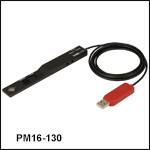
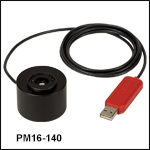
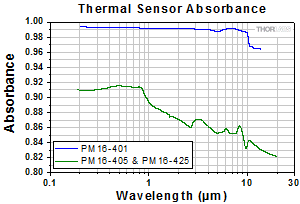
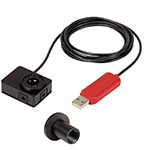
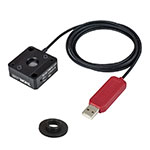
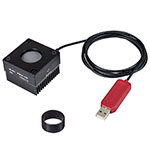









 Compact USB Power Meters
Compact USB Power Meters